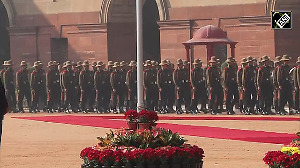'At school, on August 15, the Indian flag was raised. There was no national anthem at that time and we sang Rise India Thy Millions Lead,' recalls military legend Major General Ian Cardozo (retd).

Major General Ian Cardozo lost his leg after it was blown up by a mine on the battlefield during the 1971 War.
He overcame his disability to become the first disabled officer to command a battalion and a brigade.
The general retired after nearly forty years of service in the Indian Army.
Now 86, he was a ten-year-old school boy when India won freedom.
He remembers taking a long walk with his father on the eve of Independence Day, 1947.
"All the buildings were illuminated, the packed trams went up and down and the ships in the Bombay harbour were all lit up."
"People surged onto the streets shouting 'Inquilab Zindabad' and 'India is Free," the general remembers as he looks back at that moment in history which he can never forget.

I was 10 years old and studied at the St Xavier's School in Bombay. I lived in Colaba [south Mumbai].
As children we had experienced how the goras, the British, used to discriminate against us.
My dad worked for a Greek firm called Rallis Brothers. His office was opposite the Bombay Gymkhana. In his office, there were two staircases -- one for the whites and one for Indians. We had to use the separate staircase. There were separate toilets for Indians and we could not use the bathrooms meant for the Whites.
There were many other such instances of humiliating discrimination that we encountered and maltreatment.
In the cinema, the national anthem of England used to be played before the show. The Union Jack was shown on screen and we all had to stand up -- now there are some who make a fuss about standing up when our own National Anthem is played!

When I came to know that India was going to be free and the British would leave it was a great feeling. There was a general sense of joy around us.
I was too young to understand, but I knew that there would be an end to discrimination. I knew that we were no longer under British rule.
I remember all the buildings were illuminated, the packed trams went up and down and the ships in the Bombay harbour were all lit up. Of course, we did not understand the real connotation of freedom at that time, but this celebratory atmosphere was very appealing to me as a child.
I remember seeing our flag fluttering on buildings and being waved by people. I distinctly remember walking in the night with my father down Colaba Causeway, past the Regal cinema, the museum, Flora Fountain -- right up to Dhobi Talao and returning via the Oval, Bombay Gymkhana, back to Fountain and to Colaba.
It was quite a long walk, especially for a child, but we were so excited.
There were crowds surging from everywhere. There were shouting 'Inquilab Zindabad', 'India is free' -- It was a very, very, exciting time.

At school, the next day on August 15, the Indian flag was raised. There was no national anthem at that time and we sang Rise India Thy Millions Lead.
The school gave us a banana, bun and tea.
My journey into the army began because of my school senior, Sunith Rodrigues. He was four years older than me and had joined the first course of Joint Services Wing in Dehradun in 1949.
He came to visit the school after joining the army and I was very impressed by him. He had left school as a boy and returned as a confident, polished young adult.
He was a champion boxer and had earned a boxing blue at the NDA. I saw him and I thought the National Defence Academy was the place for me. [General Sunith Francis Rodrigues was a former chief of the army staff and former governor of Punjab. He passed away in 2022.]
So when the advertisement appeared in the paper for entry into NDA, I applied and was selected.
I have served in diverse places in our country, seeing our flag fly high on the borders still gives me goose bumps. So many soldiers have given their lives to safeguard the honour of our flag.
As told to Archana Masih/Rediff.com
Major General Ian Cardozo joined the National Defence Academy in 1954 at 16. He is the only cadet to be awarded both the gold and silver medals in the NDA's history.
His early years in the army were spent on the Pakistan and Tibet borders. He took part in the 1962 War with China, the 1965 and 1971 Wars.
He lost a leg in the 1971 War in then East Pakistan and went on to become the first disabled officer to command men on the frontlines.
A gallantry award winner, Major General Cardozo is a military legend. He served the Indian Army for 39 years and is a prolific writer. His latest book is Beyond Fear: True Stories on Life in the Indian Armed Forces.
If you have parents, grandparents, uncles, aunts, relatives, family friends who witnessed India's first Independence Day, August 15, 1947, please do tell us about their eyewitness accounts and mail it to news1995@rediffmail.com










